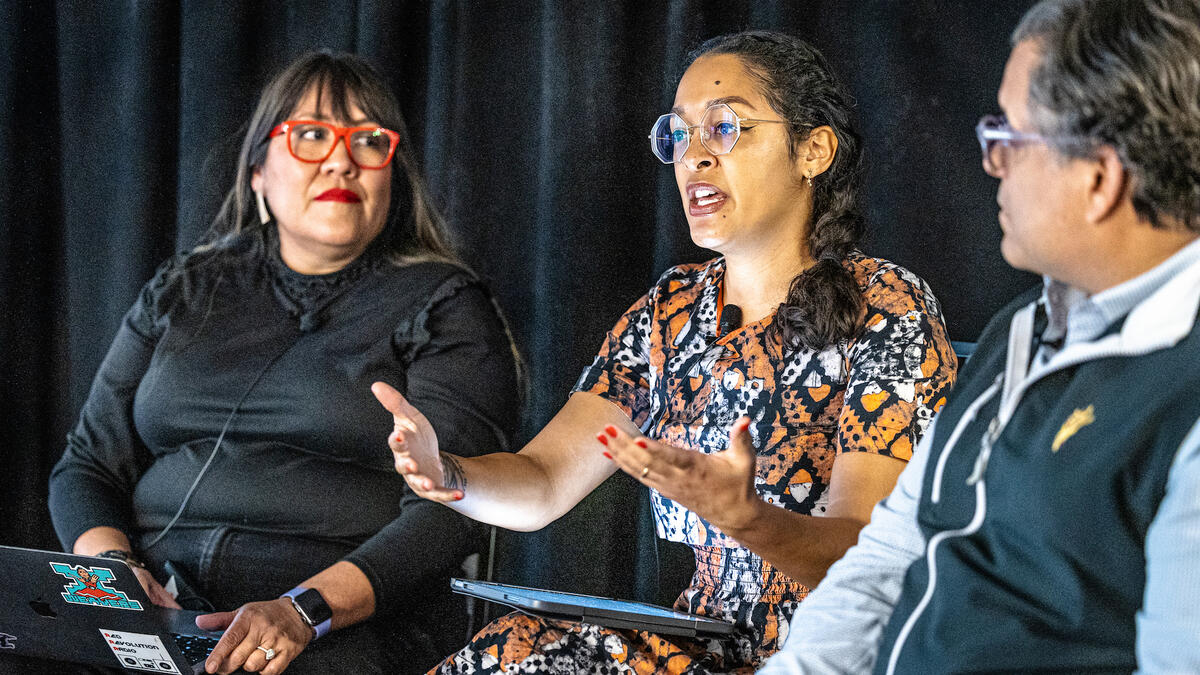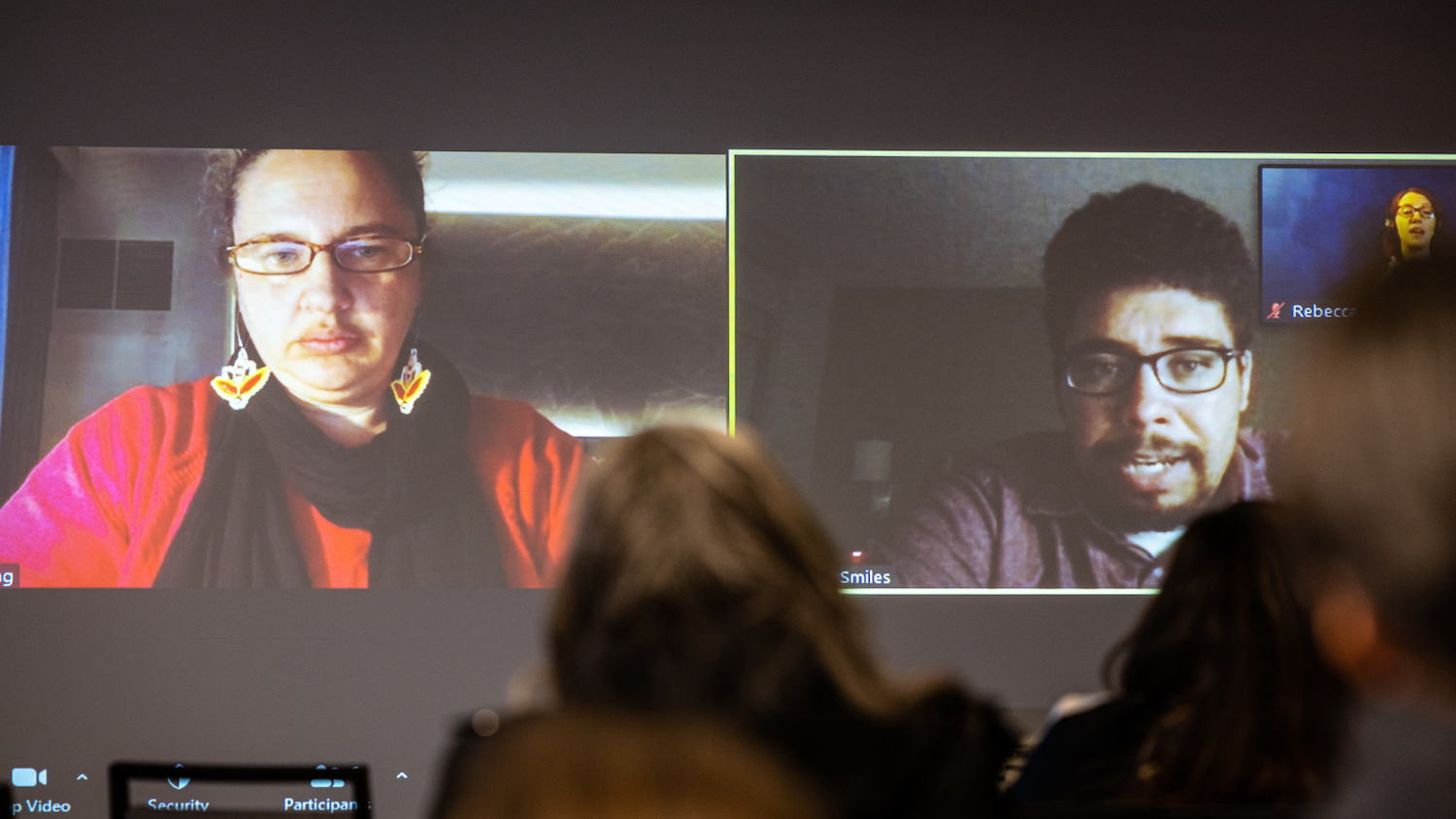Universities and colleges can do a wonderful job of solving society's problems, educating the populace and making life better for everyone. But they also can create problems — problems such as displacement and lack of equity and inclusion for unrepresented groups.
That was the premise of a Wednesday night hybrid forum titled “People, Places and Possibilities: Land and Belonging in Higher Education,” hosted by Arizona State University’s Center for Indian Education and sponsored by the Spencer Foundation.
“We are interested in the ways in which institutions of higher education might pay closer attention to the role of place in the work that they do. By place, we mean land that has been imbued with meaning,” said Bryan McKinley Jones Brayboy, President’s Professor, university vice president of social advancement and director of the Center for Indian Education. “We wanted to gather a group of people and scholars to have a conversation about what responsibilities institutions have, particularly towards Native lands and Native peoples.”
In addition to Brayboy, panelists included Amanda R. Tachine, an author and assistant professor with ASU's Mary Lou Fulton Teachers College; Eve L. Ewing, writer, scholar, cultural organizer and an associate professor at the University of Chicago; Megan Bang, professor of the Learning Sciences and director of the Center for Native American and Indigenous Research at Northwestern University; and Deondre Smiles, an assistant professor in the Department of Geography at the University of Victoria in British Columbia, Canada.
Brayboy said the forum was inspired by a March 2020 long-form investigative report titled “Land-grab Universities” by Robert Lee, a lecturer in American history at the University of Cambridge, and Tristan Ahtone, an investigative reporter and a Nieman fellow.
The study that revealed how 52 of the nation’s best-known public and private universities were funded by nearly 11 million acres of land seized from nearly 250 tribal nations. Lee and Ahtone claim these universities have dubiously confiscated these lands and benefited to the tune of half a billion dollars. The article, which won a 2021 SIGMA Award, has prompted students and faculty of many universities — including ASU – to demand acknowledgement of this injustice and the land on which they sit.
Brayboy said at the forum that ASU has done a commendable job with its land acknowledgementArizona State University's four campuses are located in the Salt River Valley on ancestral territories of Indigenous peoples, including the Akimel O’odham (Pima) and Pee Posh (Maricopa) communities, whose care and keeping of these lands allows us to be here today. . At the beginning of the event Wednesday, a video of ASU's Indigenous land acknowledgement was shared.
The Lee and Ahtone paper also states that some of these confiscated lands were promised to freed slaves, which left Black communities in the lurch.
“Institutions, sometimes intentionally or unintentionally, displace people to create themselves,” Tachine said. “Native American people in lots of institutions of higher institutions often wonder about our sense of belonging. There are different systems of power that are creating those feelings. And they’re more than just feelings. They are real actions that make it difficult for Native people to thrive.”
Professor Megan Bang from Northwestern University (left) and Assistant Professor Deondre Smiles from the University of Victoria participated in the March 22 forum "People, Places, and Possibilities" through Zoom. Photo by Charlie Leight/ASU News
Ewing said land-grant universities historically have been a mechanism for primarily white and wealthy people to accrue power, which means others get excluded.
“The more our people are left out of universities, the more the university gets to configure itself as a prestigious place, which allows it to accrue power,” Ewing said. “And yet the paradox is that we are here, right?”
Smiles said there’s more than a bit of irony when it comes to how universities honor its land and the people it once belonged to.
“At the University of Victoria where I teach, I read a land acknowledgement before every single event and I critically interrogate this,” Smiles said. “Whose relationships are they supposed to be honoring, because these perspectives are often not represented on this college campus. … I think the way we think about space and place ties into what perspectives we prioritize and what are really given center stage in higher education.”
Bang focused her comments on how and what is being taught on these ancestral lands.
“The biggest role for us is to recognize the transformation of what actually needs to happen with how we learn and what we learn,” Bang said. “The Western knowledge system separated disciplines to have a division of labor towards particular ends. As a learning scientist, how and what you think matters, and are intertwined.”
Panel members said despite what has happened in the past, they envision a brighter future for students, academics and their children — but they must continue to fight and persevere as they have done for centuries.
“This is where ancestry really becomes important,” Ewing said. “The things that our parents, grandparents and folks who we will never meet or never know their names and what they went through in order for us to be here … to sit here and have a nice dinner with you, for us to have nice glasses and clean water to drink, all the things that are so innumerable, we owe that to those who come after us.”
Top photo: Associate Professor Eve L. Ewing from the University of Chicago (center) is joined by Assistant Professor Amanda R. Tachine from ASU's Mary Lou Fulton Teachers College and President’s Professor Bryan Brayboy of the School of Social Transformation on Wednesday, March 22, at the Canopy by Hilton Tempe Downtown. The panel addressed the topic “People, Places, and Possibilities: Land and Belonging in Higher Education,” put on by ASU’s Center for Indian Education and sponsored by the Spencer Foundation. Photo by Charlie Leight/ASU News
More Arts, humanities and education

2 ASU professors, alumnus named 2025 Guggenheim Fellows
Two Arizona State University professors and a university alumnus have been named 2025 Guggenheim Fellows.Regents Professor Sir Jonathan Bate, English Professor of Practice Larissa Fasthorse and…

No argument: ASU-led project improves high school students' writing skills
Students in the freshman English class at Phoenix Trevor G. Browne High School often pop the question to teacher Rocio Rivas.No, not that one.This one:“How is this going to help me?”When Rivas…

ASU instructor’s debut novel becomes a bestseller on Amazon
Desiree Prieto Groft’s newly released novel "Girl, Unemployed" focuses on women and work — a subject close to Groft’s heart.“I have always been obsessed with women and jobs,” said Groft, a writing…



